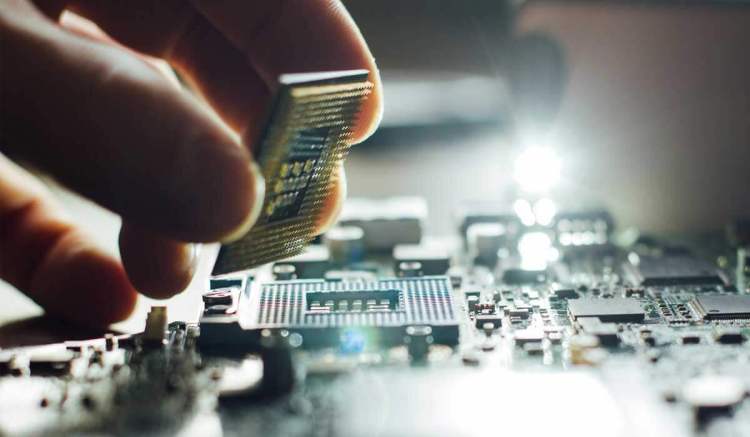AI startups have discovered there’s value to partnering with tech giants like Intel, Google, and IBM. Entrepreneurs bring the domain expertise, ingenuity, and passion, while large enterprises provide the unparalleled compute and storage capabilities critical to building modern AI systems.
“Ninety percent of the world’s supercomputers run on Intel technology,” Diane Bryant, who leads Intel’s Data Center Group, told me at SXSW. “And 95 percent of artificial intelligence solutions run on Intel Xeon and Xeon Phi processors.”
Graphics processing units (GPUs), once popular mainly with gamers chasing visual performance, inside computers represent images as matrices. Turns out the deep neural nets that power our current AI craze also depend heavily on matrix operations, making GPUs suddenly very useful for AI research. Nvidia’s stock price shot up 224 percent in 2016, making its CEO Jen-Hsun Huang even richer.
Intel’s Xeon Phi competes directly with Nvidia’s GPUs. When asked about Intel’s competitive advantage, Bryant explained the difference between a general purpose GPU, or GPGPU, and specialized computing technology: “Nervana technology is designed specifically for neural networks. There’s no overhead of pixel processing like for GPGPUs, so there’s a 2-4x improvement with specialized computing.”
June 5th: The AI Audit in NYC
Join us next week in NYC to engage with top executive leaders, delving into strategies for auditing AI models to ensure fairness, optimal performance, and ethical compliance across diverse organizations. Secure your attendance for this exclusive invite-only event.
Everyday applications for AI
Every major tech company in Silicon Valley is battling to gain ground in self-learning technologies. Artificial intelligence is now table stakes for technology enterprises — and it benefits more than just shareholders.
Consistent architecture and specialized hardware make life simpler for developers building AI applications. On stage at SXSW, Bryant invited several entrepreneurs and executives building on top of Intel technology, including Jason Mars of Clinc and Luca Candela of FarmLogs, to demo their technology.

Above: Jason Mars demos the financial chatbot Finie made by his company, Clinc. Image Credit: Intel Corporation.
Clinc built a powerful digital assistant named Finie to allow you to converse with your bank account. If you’re the type who hates accounting, you can simply ask Finie questions like “How much did I spend on my Vegas trip last month?” and she’ll intelligently parse your request and get an answer to you right away. FarmLogs applies AI to help farmers automatically track farm activity, analyze crop health, and answer questions about optimal crop rotations.
Bryant also highlighted several Intel AI projects advancing innovation in sports, health care, and humanitarian causes. An athlete seeking performance analytics normally needs to incur an expensive lab visit, where sensors are placed on his or her body for tracking. Using AI-assisted motion capture technology, athletes and their coaches can get real-time feedback on the spot with mobile devices.

Above: Diane Bryant tests the AI-Assisted Motion Capture Technology made by the Intel Sports Group. Image Credit: Intel Corporation
AI that can save lives
“Half of men and one third of women will be diagnosed with cancer in their lifetimes,” said Bryant. “The average accuracy for human radiologists is 75 percent. For machines, it’s 85 percent. Intel health care technology is already commercially deployed in China and has served over 5,000 patients.” Intel also has a partnership with Penn Medicine, which uses AI to mitigate hospital re-entry due to heart failure and correctly identify 20 percent more at-risk patients.
In another use of AI, the National Center for Missing & Exploited Children (NCMEC) seeks to identify underage sex trafficking victims who end up on pornography sites. NCMEC has a hotline for callers to report suspected child pornography, which received over 10 million alerts in 2016. Each alert can take over 30 days to process due to the difficulty of matching photos on porn sites to NCMEC’s huge database of missing children. With AI from collaborators Intel, Microsoft, and Google, this monthlong process is reduced to a single day, since computers do visual matching much faster at scale than humans can and can shortlist the highest potential matches for staff review.

Above: Matching outdated photos of missing children to possible photos of them found on the internet is a challenge AI helps solve. Image Credit: Intel Corporation.
“You need scale to achieve a meaningful AI result,” Bryant warned. While AI startups crop up every day, the enormous scale and infrastructure that tech titans like Intel, IBM, and Google have enable them to apply the requisite compute and storage capabilities to tough problems in health care and social good.
Google’s DeepMind, originators of AlphaGo, the deep learning algorithm that defeated 17-time international Go champion Lee Sedol in 2016, also has a department dedicated to AI for health care research. To tackle the issue of legacy and paper-based systems in hospitals, DeepMind Health’s first product is a mobile app called Streams that promises to centralize essential patient information and serve timely alerts at the moment of care. IBM Watson is similarly prioritizing health care with AI solutions for genomics, oncology, drug discovery, personalized care, patient engagement, and clinical trials.
While technology giants may be fighting a zero-sum game for AI dominance, humanity and society still benefit from their constant, rapid-pace investment in powerful new hardware and algorithms.
This story originally appeared on Www.topbots.com. Copyright 2017


